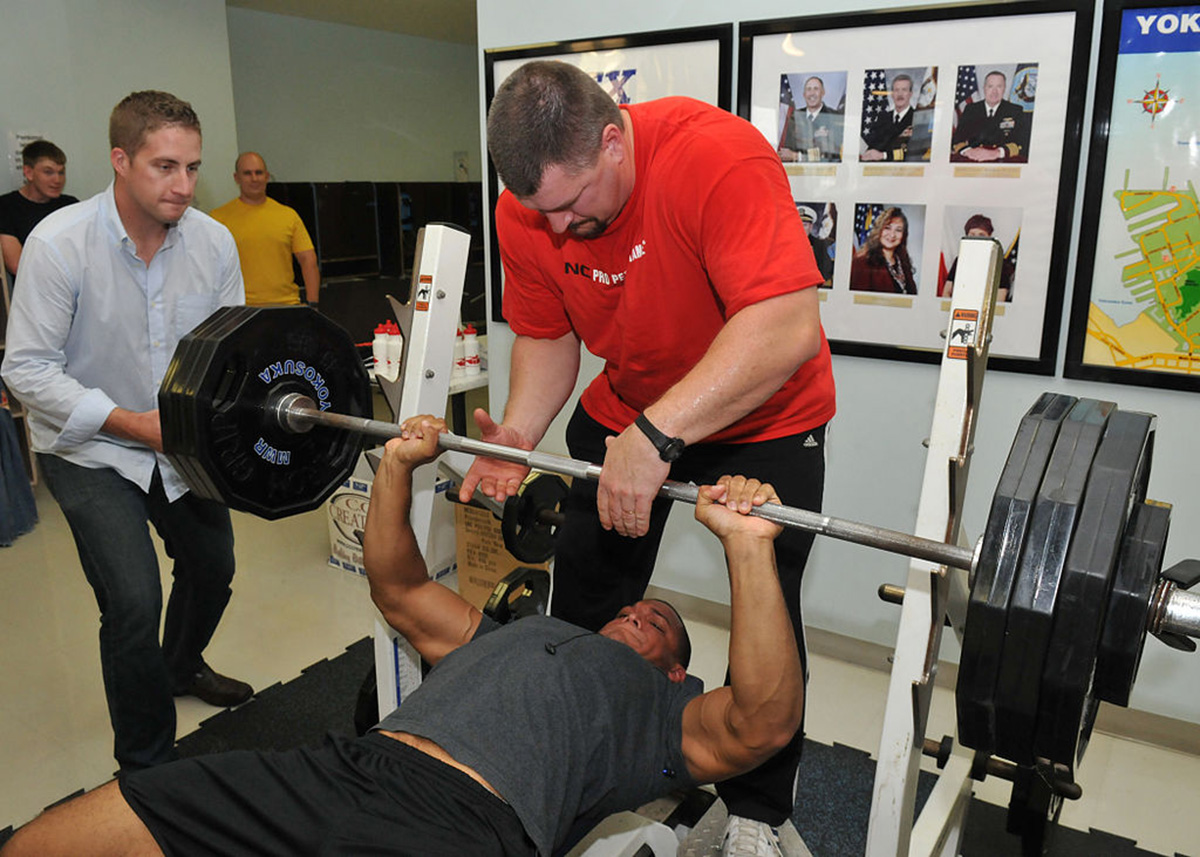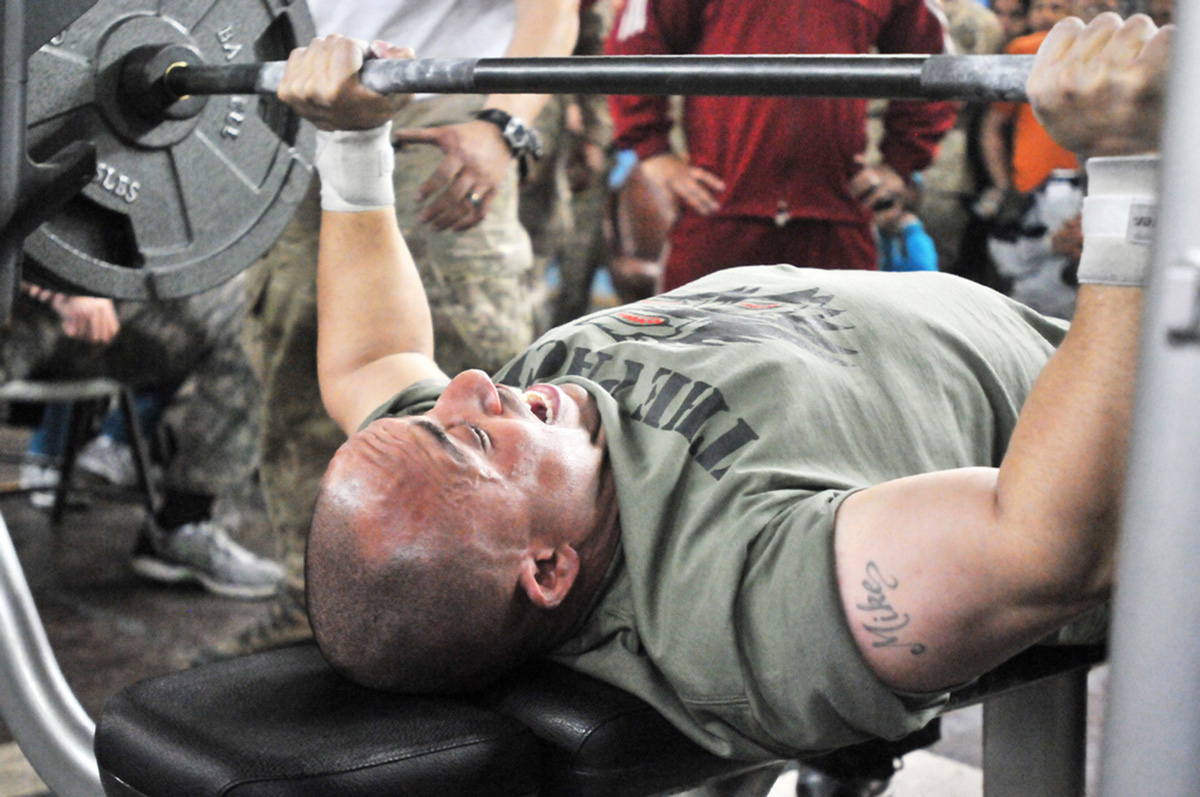Try to get on the bench press at your gym on a Monday evening and it’s a nightmare. It seems like Monday has become the unofficial international chest day.

Now, for an aspiring powerlifter, you might think this is a good thing. With so many people using the bench press in a condensed period of time, you’ll probably pick up loads of useful bench pressing tips, right?
Not so much. Despite the fact the bench press is one of the most popular exercises in the gym, and the one the average gym goer associates most with strength and being the pinnacle of performance, most peoples’ bench press form is shocking.
First up, very few people perform proper reps.
When we say proper reps, that’s starting each rep with your arms straight, touching your chest, pausing briefly, then pushing back up until your elbows are lock out again. If, by some miracle, the hench dude you’re watching gets this bit right, take a look at his feet – are they on the floor? Is his butt on the bench? And does he keep his upper back and head pressed down at all times? If not, he’s not the guy you want to learn your technique from.
The bench press isn’t just a chest. Shoulders and triceps exercise, it’s an “everything” exercise. To make the most of your potential pressing strength, you need to recruit every muscle in your body. You’ve got to nail your technique, then use your newfound skill when implementing bench presses in your routine.
How to Bench Right
Here are the key tips and tricks you need to know for getting your bench form perfect. Anything less than perfect form and you’re losing efficiency, potentially forfeiting tens, or even hundreds of pounds worth of strength:
Get Tight
The tighter you can hold your whole body, the more muscles your activate. The more muscles you activate, the stronger you’ll be and the more you’ll bench.
Grip the Bar
Reach up and grasp the bar with your hands slightly wider than shoulder-width apart. Wrap your thumbs around the bar for a secure grip.
The Set Up
Lie flat on the bench to begin with and hold the bar with a slightly wider than shoulder width grip. The wider you get your grip, the shorter your range of motion, and the more you’ll be able to lift. BUT – a wide grip requires superbly mobile and strong shoulders, so begin with just outside shoulder width, and gradually work your way toward a wider grip. Squeeze the bar as tightly as you can.
Feet, Hips and Head
Once you’ve got your grip set, bring your feet up onto the bench, and push your back and head down hard. This may look odd, but you need to get your upper back and head pushed down into the bench as firmly as you can. When you’re in a stable position, put one foot on the floor. This foot should be under your hip, with the sole flat. Just like you did with your back and head, push down hard, then take the other foot down and do the same. In this position your butt should be tight to the bench, and there’ll be a slight arch in your lower back.
Read More: Optimize Your Time In The Gym
The Press
Take the bar out of the rack and hold it directly above your chest. Lower it down slowly until it touches your chest. Pause for a moment, then drive it back up with all the force you’ve got. Squeeze your whole body as you lift up, make sure your elbows stay tucked in and keep going until your arms are completely straight.
Some additional tips
- Don't lift your buttocks off the bench. This can put your lower back at risk of injury.
- Avoid bouncing the bar off your chest. The motion should be controlled both on the way down and the way up.
- Avoid locking your elbows completely when you push the bar up. This can put unnecessary stress on your elbow joints.
- Always use a spotter when lifting heavy weights for safety.
- Warm up before you start your bench press. This can be with some light cardio or by doing the bench press motion with very light weights.
Benching For Success – The Program
As with any of the big three lifts – the squat and deadlift being the other two – getting an awesome bench requires plenty of practice. Therefore, you’ll be benching three times per week.

Each session has a slightly different version of the bench press.
Session one is a paused bench press, performed with a three count pause when the bar is on your chest. Either count this in your head, or have a training partner give you the count out load. Session two is speed bench presses, performed like a regular bench press, but with lighter weights and maximum acceleration, while session three is all about good old regular bench presses.
You’ll also have other accessory exercises each workout and a fourth session for your lower body to keep your squats and deadlifts ticking over. You’re not looking to make any strength increases on these while focusing on your bench though.
This program uses one rep maximums to dictate your weights. If you don’t know your one rep max on the bench press, squat and deadlift, test them two weeks before you start the routine.
Day 1:
Paused Bench Press – 4 sets of 6 using 65% 1RM
Incline Dumbbell Press – 4 sets of 6
Wide Grip Lat Pulldowns – 4 sets of 8
T Bar Rows – 4 sets of 8 reps
Close Grip Pushups – 3 sets to failure
Day 2:
Squats – 5 sets of 5 reps using 75% 1RM
Deadlifts – 5 sets of 3 reps using 80% 1RM
Lunges – 5 sets of 8 reps each leg
Lying Leg Curls – 3 sets of 12 to 15 reps
Calf Raises – 3 sets of 12-15 reps
Hanging Leg raises – 3 sets of 12-15 reps
Day 3: Rest
Day 4:
Speed Bench Press – 8 sets of 3 using 70% 1RM
Close Grip Bench Press – 5 sets of 5 using 70% 1RM
Dumbbell Rows – 4 sets of 6 reps
Face Pulls – 4 sets of 10 reps
Dumbbell Shoulder Presses – 4 sets of 10 reps
Barbell Curls – 4 sets of 6 reps
Day 5: Rest
Day 6:
Bench Press – Work up to a maximum set of 8-10 reps in week one, a maximum set of 4-6 reps in week two and a maximum set of 2-3 in week three.
Incline Bench Press – 3 sets of 6 reps
Chin-Ups – 5 sets of 8 reps
Cable Rows – 5 sets of 8 reps
Dips – 3 sets of 6 reps
Day 7: Rest
Read More: 10 Tips To Feel Comfortable And More Confident In The Gym
Notes:
The program is designed to run for three weeks. Day 6 has been outlined for each week above, but for all the other days, you should keep your weights/reps the same week on week. Repeat the three weeks twice but increase all your lifts by 5 to 10 pounds. This brings you up to nine weeks in total. Take week 10 nice and light, by working at around 50 percent of your usual intensity, then go back to the gym on Monday of the following week and re-test your bench press maximum.
This should result in anywhere from a 15 to 50 pound increase on your bench.
- "Bench Press" by Mike Robertson, August 4th, 2011: robertsontrainingsystems.com/blog/bench-press/
- Photo courtesy of U.S. Navy photo by Mass Communication Specialist 1st Class Brock A. Taylor by Wikimedia Commons : en.wikipedia.org/wiki/File:US_Navy_100913-N-3215T-149_American_professional_iron_man_athlete_Karl_Gillingham_spots_Hospital_Corpsman
- Photo courtesy of isafmedia by Flickr : www.flickr.com/photos/isafmedia/6910756711/


Your thoughts on this